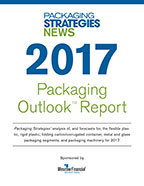CoverStory: Flexible Packaging
Flexing packaging’s muscles
Flexible packaging builds a strong presence in the industry.

McCormick Skillet Sauce pouches offer a unique look and an easy-to-use package.

ZIG Portable Protein Shakes make shakes easier to take on the go.

ECOTEAS feature a “zero waste” package made from compostable and recyclable materials.

Ecolean’s Air Aseptic Clear pouches let consumers have their beverages and see them too.






Flexible packaging may be offering lightweight alternatives to rigid packs, but it’s no lightweight in the packaging industry. In fact, flexible packaging continues to be one of the fastest growing packaging segments in the U.S. According to the Flexible Packaging Association (FPA, flexpack.org), the U.S. flexible packaging industry grew 2.8% to $27.2 billion in annual sales in 2013. Overall, flexibles make up 18% of the $145-billion U.S. packaging market according to the FPA’s 2012 “State of the US Flexible Packaging Industry” report. Flexible is a packaging segment on the move.
Moving right along
And it’s not the only thing on the move. Consumers lead busier and busier lives and with this comes a need for products that function on-the-go. The ZIG Portable Protein Shake from Luminate Nutrition, LLC, uses flexible packaging to make their protein products more convenient for on-the-move consumers. Protein shakes are a popular choice for pre- or post-workout nutrition and as a healthy snack between meals. Perimeter Brand Packaging (perimeterbp.com) and ORC International, a global market research firm, conducted a study among 1,000 consumers and the study revealed that 66% of powder users drink the product away from home at least four times a week. Consumers also listed their ideal packaging elements including the desire to eliminate measuring scoops and getting a good, smooth mix. Perimeter developed the BlenderPak packaging to solve their problems for consumer who felt the current offerings weren’t meeting their needs. According to Katy Glabicky, a fitness trainer and ZIG Advisory Board member, blending bottles are bulky and risk bad odors if they aren’t cleaned right away. Ready-to-drink shakes are heavier and refrigeration is an issue. Glabicky called launching ZIG with Permiter’s BlenderPak packaging a “no brainer.” The lightweight packs feature a built-in mixing mesh design for clump-free shakes, come packed with a pre-measured portion of protein powder, can easily be transported in a gym back and eliminate the mess of mixing by just allowing consumers to add water directly to the package.
Flexibility in flexible
In addition to functioning on the go, consumers want packaging that is convenient. This doesn’t just apply to flexible packaging, but flexible has done a good job of making itself a convenient option for brands and consumers alike. Bemis (Bemis.com), which was recognized as a winner of the FPA Flexible Packaging Achievement Awards for the McCormick Skillet Sauce pouch, saw a way to give consumers the convenience they desire. The sauce pouches allow consumers to cook quick and healthy meals at home with the ease of a pre-made sauce. The pouches feature an easy-to-open “cap,” which simply tears away without the use of scissors. The sauce can then be squeezed from the package without needing any additional tools like spoons, scoops or spatulas. The unique shape of the pouches also offers shelf appeal and brand recognition.
Sustaining flexibility
Flexible packaging may be booming, but it isn’t without its concerns. Many want to know how flexible films will impact the environment. Much of flexible packaging’s sustainability comes from its reduced materials usage and lighter weight. The McCormick Skillet Sauce pouch offers a more sustainable option by being lighter than the bottle and jars in the skillet sauce category. However, sustainability doesn’t stop there. Many companies are looking for new materials that will allow them to offer the flexibility consumers desire along with more sustainable options such as recycling, composting and more. ECOTEAS packs their individual tea bags using NatureFlex films from Innovia Films (innoviafilms.com). The material, derived from wood pulp, is certified over 90% bio-based and is compostable. To make the package even more sustainable, ECOTEAS has removed the tags, strings and staples. The resulting package is billed at “100% zero waste.” The tea, filter paper and wrapper are compostable and the carton is recyclable. Additionally, the packaging material offer high barriers to oxygen and moisture to maintain fresh tea for the product’s entire shelf life. For more about sustainability and flexible packaging check out the side bar on “The advantages of flexible packaging.”
Clearing things up
Consumers like to see the goods they are buying. Recently, some flexible packages have run into trouble because consumers found that products could be compromised without them noticing because the packages were entirely opaque. The makers of the popular Capri Sun pouch responded to this consumer concern by adding a clear panel to the bottle of their package to allow consumers to ensure the juice they gave their children was as healthy as they expected it to be. Ecolean (ecolean.com) has come up with an even clearer solution with their new Ecolean Air Aseptic Clear package. The transparent and lightweight pouches are suitable for non-carbonated soft drinks. They also offer a printable surface so brands can determine how much of the product to showcase, while maintaining brand impact. The pouches are available in 200 and 250ml sizes, and Ecolean recently introduced their new EL4+ filling system, which is capable of filling up to 12,000 packs per hour, making the transparent pouches a clearly viable beverage packaging option.
Flexible packaging is continuing to grow and innovate to better meet consumer needs and create new options for packagers. With improved convenience, sustainability and clarity, flexible packaging stands to pack quite a punch despite its “lightweight” status. For more about flexible packaging, check out our Global Pouch Forum coverage on page 36.
The advantages of flexible packaging
Kevin Young, president of Consumer Goods Packaging at Mondi North America (mondigroup.com), gave us some insight about the advantages flexible packaging has to offer brands and consumers alike.
Food & Beverage Packaging: What do you see as the biggest advantages to flexible packaging?
Kevin Young: Flexible packaging lends itself to design innovations that deliver benefits both to brands and their end user customers. Consider the industry’s reaction to needs among seniors, one of North America’s fastest growing demographic sectors. The American Association of Retired Persons (AARP) tells us that roughly 8,000 Baby Boomers are retiring daily, and that this rate will continue until 2029.
Flexible packaging manufacturers are responding with design improvements that make packaging easier to carry, easier to open and also to reseal. Pouches with extra-large caps, for example, offer seniors a more secure grip with which to twist the cap open. Likewise, pouches are being produced with tear notches and a seam that permits the bag to be torn open with a moderate pull and then resealed by applying light pressure. Flexible packages with comfortable handles are catering to seniors’ needs for easier to carry packaging. These design improvements are giving producers of food, personal and home care products advantages on the retail shelf when seniors make their product buying decision.
Design improvements are assisting singles and on-the-go couples, as well. Flexible baby food pouches, for instance, are a convenient, safer packaging method than conventional jars. Parents can allow children as young as one to grasp the flexible pouch and feed themselves under parental supervision. The pouches can be equipped with choke-proof caps that would allow the passage of air should a child place the cap in its mouth.
Single-serve and resealable pouches are appealing to the singles demographic and to all sectors that are concerned with waste.
Flexible packaging also offers certain brand promotion and consumer information benefits. It can be printed with brilliant imagery via rotogravure or new high definition flexographic printing on all six sides to present logos and product information, coupons and usage directions, and literally any other messaging desired. Pouches with clear windows are gaining traction in the market, as well. They enable brands to give consumers a look at the actual product being purchased.
Looking ahead, the food & beverage sector represents a great opportunity for brands to benefit from flexible packaging innovations. For example, the liquid food & beverage market, from wine to baby food, is expected to transition from rigid and semi-rigid to flexible packaging at a rate of 10% - 15% per annum. As this transition takes place, the flexible packaging industry will respond with innovations that satisfy the sector’s needs.
FBP: What are some of the challenges with flexible packaging and how can companies overcome them?
Young: One challenge has to do with our participating in a global marketplace that presents persistent competitive pressures. Smart packaging companies today are draining every bit of waste possible from their operations through lean programs, a practice that helps keep manufacturing efficiency, product quality and innovation running at optimum levels.
FBP: How can flexible packaging help companies offer sustainable packaging?
Young: Flexible packaging is giving a considerable boost to the sustainability movement. It is lighter and easier to organize in boxes and on pallets than rigid and semi-rigid packaging, which reduces needs for space in inventory and transit. It also cuts transport costs and reduces the amount of material necessary to store a product. New properties in barrier films are helping brands achieve longer shelf life, especially for food products, which helps reduce waste.
Flexibles make up 18% of the overall $145-billion US packaging market.*
66% of protein consumers drink protein powder away from home.
In 2013 the U.S. flexible packaging industry grew 2.8 percent to $27.2 billion in annual sales.**
Breakdown of flexible packaging end-use market*
Retail food 49%
Retail non-food 12%
Consumer products 10%
Industrial 11%
Medical and pharmaceutical 8%
Institutional food 7%
Institutional non-food 5%
*FPA’s 2012 “State of the U.S. Flexible Packaging Industry” report
** FPA’s 2014 “State of the U.S. Flexible Packaging Industry” report
Looking for a reprint of this article?
From high-res PDFs to custom plaques, order your copy today!












